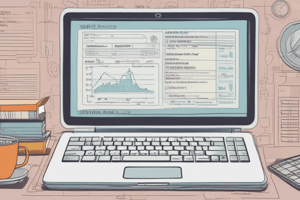Podcast
Questions and Answers
What is the main assumption of the First-In, First-Out (FIFO) method?
What is the main assumption of the First-In, First-Out (FIFO) method?
- Goods are used based on their cost
- Goods are used in the reverse order in which they are purchased
- Goods are used randomly regardless of purchase order
- Goods are used in the order in which they are purchased (correct)
What is the advantage of using the Average-Cost method?
What is the advantage of using the Average-Cost method?
- It is easy to implement
- It is not subject to income manipulation (correct)
- It is more accurate than FIFO
- It is only used for periodic inventory
What is the main characteristic of the Moving-Average method?
What is the main characteristic of the Moving-Average method?
- It computes a new average unit cost each time a purchase is made (correct)
- It uses the weighted average cost of all purchases
- It computes a new average unit cost at the end of the period
- It only uses the cost of the most recent purchase
What is the purpose of calculating Goods Available for Sale?
What is the purpose of calculating Goods Available for Sale?
What is the main difference between the Weighted-Average method and the Moving-Average method?
What is the main difference between the Weighted-Average method and the Moving-Average method?
What is the main advantage of using the FIFO method?
What is the main advantage of using the FIFO method?
What is the main limitation of measuring a specific physical flow of inventory?
What is the main limitation of measuring a specific physical flow of inventory?
What is the main characteristic of the Cost Flow Methods?
What is the main characteristic of the Cost Flow Methods?
What is the relationship between the ending inventory and the current cost when using the FIFO method?
What is the relationship between the ending inventory and the current cost when using the FIFO method?
What is the main purpose of using a Cost Flow Method?
What is the main purpose of using a Cost Flow Method?
Flashcards are hidden until you start studying
Study Notes
Inventory Classifications and Systems
- Inventories are assets held for sale in the ordinary course of business or goods to be used in the production of goods to be sold.
- Merchandising companies have one inventory account, while manufacturing companies have three inventory accounts: Raw Materials, Work in Process, and Finished Goods.
- There are two types of systems for maintaining inventory records: perpetual system and periodic system.
Perpetual and Periodic Systems
- Perpetual system: purchases are debited to Inventory, and Cost of Goods Sold is debited and Inventory is credited for each sale.
- Periodic system: purchases are debited to Purchases, and Ending Inventory is determined by physical count.
- Perpetual system provides a continuous record of the balance in both the Inventory and Cost of Goods Sold accounts.
Inventory Cost Flow Methods
- Specific Identification Method: identifies specific costs with specific inventory items.
- Average-Cost Method: prices items in the inventory on the basis of the average cost of all similar goods available during the period.
- Weighted-Average Method: calculates a weighted-average cost of goods available for sale.
- Moving-Average Method: computes a new average unit cost each time a purchase is made.
- First-In, First-Out (FIFO) Method: assumes goods are used in the order in which they are purchased, approximating the physical flow of goods, and ending inventory is close to current cost.
Studying That Suits You
Use AI to generate personalized quizzes and flashcards to suit your learning preferences.




